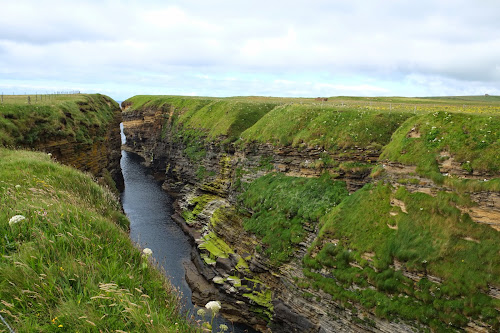Thursday 17th July - Orkney Islands
We arrived by ferry from Scrabster (Scotland mainland) to Stromness (Orkney) on Thursday 17th July at around 3.30pm. The ride over on the ferry was good, not rough, simply a gentle 'rolling'...I would hate to think what it could be like with the weather they can get get up here!
We got to our accommodation over in Kirkwall, on the eastern side of Orkney. The B&B again was lovely. The standard of B&Bs over here is exceptional. We took a drive, a park and a walk - just to find a laundromat. Found one, and 45 minutes later, clean undies and shirts again....magic! The town is quite old,and really nothing special. It is clearly an area that lives within its means nothing too flash. We found a very upmarket hotel around the corner for dinner, the Kirkwall Hotel. This place is very shmick, out of the roaring twenties. And we enjoyed the atmosphere and food very much....two days later we found the same pub had a public bar of the other side of the same premises and the food was exactly the same, only half the price!!!!
Friday 18 July - Saturday 19 July
Over the two days we explored two joined islands within the Orkneys. When I say joined, they are in fact linked by a number of causeways. These were built during the Second World War at the direction of Winston Churchill. They are referred to as Churchills barriers. The Orkneys had been a major port for the Brithish Navy in both the First and Second World Wars. In WW 1, the straights between the Islands had been blocked by the placement of old sunken shipping to protect the main harbour from sideways attack. However, these ships had rusted and shifted over the years leading up to WW 2. As a consequence, a German submarine was able to gain access and sink a British ship, resulting in 800 deaths. Churchill immediately instructed the use of Italian prisoners of war to be used to build causeways between the Islands. Firstly to protect ships, secondly to allow for a roadway escape of troops if required and thirdly, to give Italian POWS something to do! And they did a great job! The causeways are still the only link between the Islands. Whilst there , the Italians also built a church from leftover army materials and waste. They did a magnificent job,and the church still looks amazing!
Other than the military sites from both world wars, Orkney is also known for its Neolithic sites, standing stones, burial mounds, Viking long houses etc. whilst interesting to many, you seen 1 standing stone you've seen em all!
In all seriousness, we visited many sites some of which are touted as being the oldest evidence in the world of man some 3500 years old. ( they haven't seen our rock art!) but we did go to a current archaeological dig.
They do have some spectacular coastline tho!
Your in travel on the North Sea



























No comments:
Post a Comment